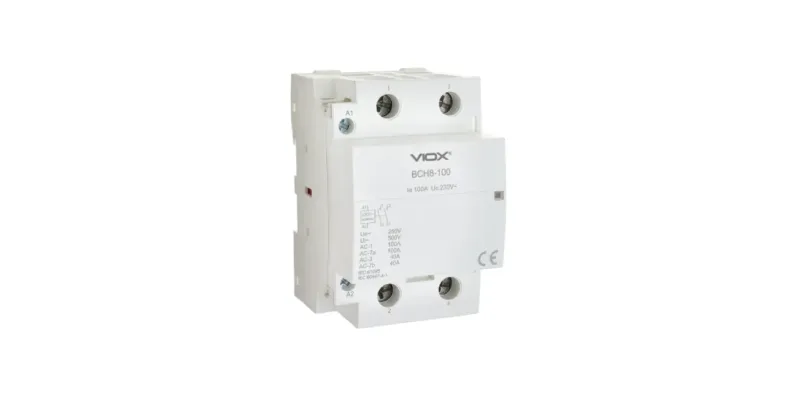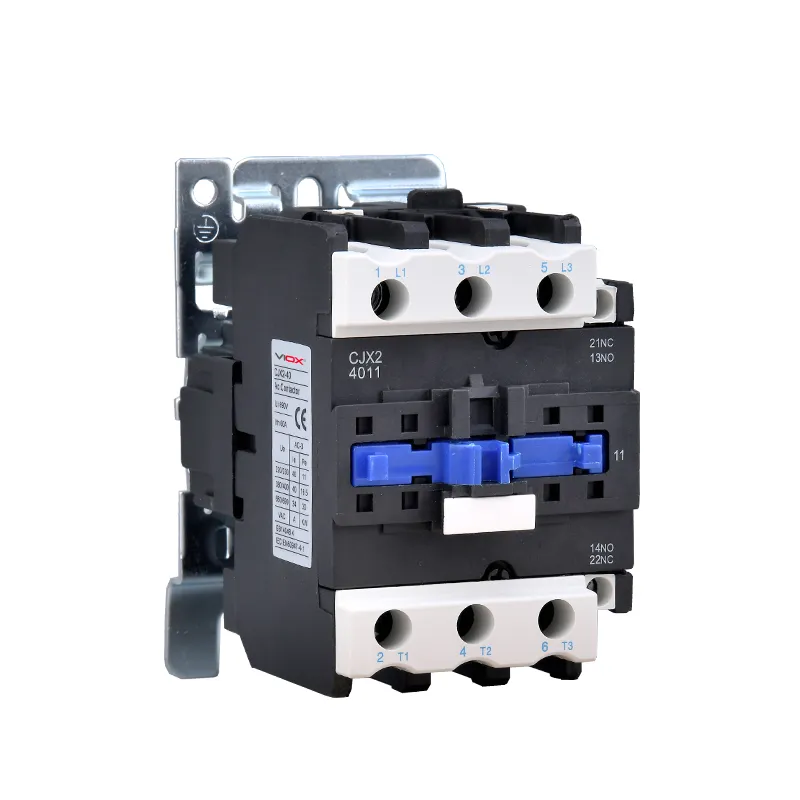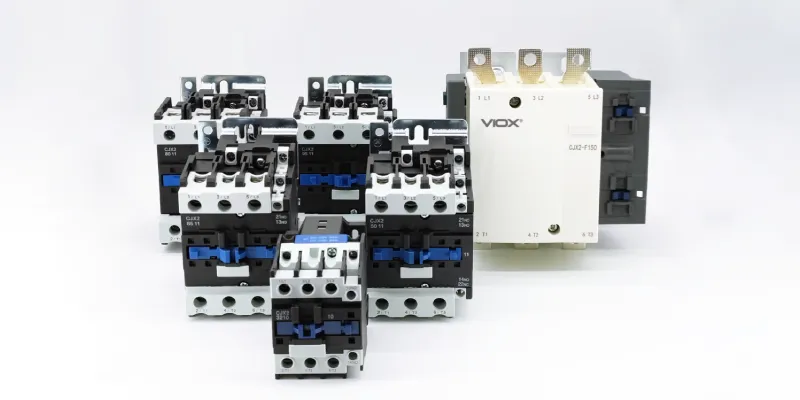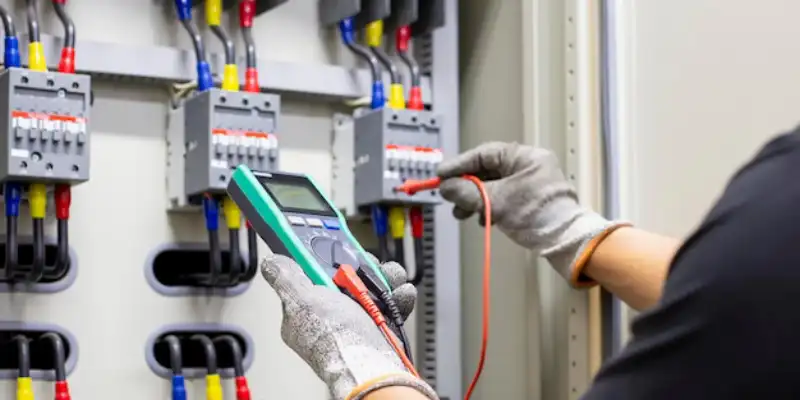Respuesta Rápida: La principal diferencia entre un contactor modular y un contactor tradicional (contactor normal) es su diseño de montaje y configuración. Los contactores modulares están diseñados para Riel DIN Se montan en paneles eléctricos con anchos modulares estandarizados, mientras que los contactores tradicionales (normales) suelen utilizar configuraciones de montaje con tornillos o en panel. Los contactores modulares ofrecen una instalación que ahorra espacio, un mantenimiento más sencillo y un dimensionamiento estandarizado, lo que los hace ideales para los diseños de paneles eléctricos modernos.
¿Qué es un contactor modular?
Un contactor modular Es un dispositivo de conmutación electromagnético compacto, diseñado específicamente para sistemas de montaje en riel DIN. Estos contactores presentan anchos modulares estandarizados (normalmente medidos en incrementos de 17,5 mm) y están diseñados para integrarse a la perfección en paneles de distribución eléctrica modernos junto con otros dispositivos modulares como interruptores automáticos y relés.
Características clave de los contactores modulares:
- Sistema de montaje en riel DIN para instalación sin herramientas
- Anchos modulares estandarizados (1, 2, 3 o 4 módulos de ancho)
- Diseño vertical compacto Optimización del espacio del panel
- Terminales de acceso frontal para facilitar el cableado y el mantenimiento
- Contactos auxiliares integrados en la mayoría de los modelos
¿Qué es un contactor tradicional (contactor normal)?
Un contactor tradicional (también llamado normal o convencional) contactor) es un dispositivo de conmutación electromagnético tradicional que utiliza configuraciones de montaje con tornillos o en panel. Estos contactores han sido el estándar de la industria durante décadas y están diseñados para montaje directo en paneles eléctricos, centros de control de motores o placas de montaje.
Características clave de los contactores tradicionales (contactores normales):
- Montaje con tornillos o pernos a paneles o placas de montaje
- Mayor huella física con orientación horizontal
- Diseño de bloque de terminales tradicional con terminales de tornillo
- Bloques de contactos auxiliares separados (a menudo opcional)
- Clasificaciones de corriente más altas disponibles (hasta 1000A+)
Comparación completa: contactores modulares y tradicionales (contactores normales)
| Característica | Contactor Modular | Contactor tradicional (contactor normal) |
|---|---|---|
| Método de montaje | Clip para riel DIN | Montaje con tornillos/pernos |
| Espacio del panel | Compacto (17,5-70 mm de ancho) | Huella más grande (varía) |
| Tiempo de instalación | 30-60 segundos | 5-15 minutos |
| Clasificaciones De Corriente | 5-125 A típico | 5-1000A+ disponibles |
| Rango De Tensión De | 24 V-690 V CA/CC | 24 V-1000 V CA/CC |
| Contactos auxiliares | Generalmente integrado | A menudo, complemento independiente |
| De Administración De Cables | Organizado, compacto | recorridos de cables tradicionales |
| Acceso de mantenimiento | Accesible desde el frente | Puede requerir la extracción del panel |
| Costo por unidad | De moderada a alta | Baja a moderada |
| Normalización | Alto (estándares IEC) | Variable según el fabricante |
Aplicaciones y Casos de Uso
Cuándo utilizar contactores modulares
Aplicaciones ideales:
- Sistemas de automatización de edificios Requiere acceso frecuente al panel
- Paneles de control de motores con limitaciones de espacio
- Sistemas de control de la iluminación en edificios comerciales
- Paneles de control HVAC con múltiples requisitos de conmutación
- Armarios de control de máquinas que requieren componentes estandarizados
Casos de uso específicos:
- Estaciones de control de bombas con espacio de panel limitado
- Contactores de iluminación LED en salas eléctricas
- Controles de motores de transportadores en la fabricación
- Controles de unidades de tratamiento de aire en edificios comerciales
Cuándo utilizar contactores tradicionales (contactores normales)
Aplicaciones ideales:
- Control de motores industriales pesados que requieren altas clasificaciones de corriente
- Reemplazos de sistemas heredados manteniendo las configuraciones existentes
- Sensibles a los costos de los proyectos donde el espacio no está limitado
- Aplicaciones de alta potencia clasificaciones superiores a 125 A
- Las instalaciones al aire libre Requiere recintos robustos
Casos de uso específicos:
- Arrancadores de motores grandes (50 HP y más)
- Controles de hornos industriales
- Contactores de maquinaria pesada
- Controles de equipos de minería
⚠️ Consideraciones de seguridad
Requisitos críticos de seguridad:
- Desactive siempre los circuitos antes de la instalación o el mantenimiento
- Verificar las clasificaciones de corriente adecuadas para su aplicación específica
- Seguir a NEC/CEI códigos de instalación para la selección del contactor
- Utilice una protección contra arco eléctrico adecuada basado en el tipo de contactor
- Asegúrese de que haya una ventilación adecuada alrededor de los contactores para evitar el sobrecalentamiento
Notas de instalación profesional:
- Los contactores modulares requieren Instalación correcta del riel DIN con recorte seguro
- Los contactores normales necesitan par de montaje adecuado presupuesto
- Ambos tipos requieren tamaño adecuado del cable según los códigos eléctricos
- Cableado de contactos auxiliares debe coincidir con los requisitos de voltaje de control
Criterios de selección: Cómo elegir el contactor adecuado
Paso 1: Determine sus requisitos actuales
Calcula tu corriente de carga:
- Cargas del motor: utilice la corriente de la placa de identificación del motor × 125%
- Cargas resistivas: utilice la corriente de carga real
- Cargas de iluminación: considere las características de la corriente de entrada
Paso 2: Evaluar las restricciones de espacio
Evaluación del espacio del panel:
- Elija modular Si el espacio del panel es limitado (hay menos de 4″ de ancho disponible)
- Elija normal Si tiene suficiente espacio en el panel y necesita clasificaciones más altas
- Considere las necesidades futuras de expansión
Paso 3: Considere los requisitos de instalación
Factores de instalación:
- Ventaja modular: Instalación sin herramientas, apariencia organizada.
- Ventaja normal: Instalación familiar para la mayoría de los técnicos.
- Requisitos de accesibilidad de mantenimiento
Paso 4: Análisis del presupuesto
Consideraciones de costos:
- Costo inicial: Los contactores normales suelen ser menos costosos
- Costo de instalación: Los contactores modulares reducen el tiempo de mano de obra
- Valor a largo plazo: Considere los costos de mantenimiento y actualización
🔧 Consejos de instalación de expertos
Para contactores modulares:
- Verificar la compatibilidad del riel DIN (riel estándar de 35 mm)
- Dejar espacio de expansión de al menos un ancho de módulo
- Utilice marcadores de alambre para la identificación organizada
- Instalar de izquierda a derecha siguiente secuencia lógica de control
- Compruebe el enganche del clip tirando suavemente después de la instalación
Para contactores tradicionales (contactores normales):
- Utilice el par de montaje especificado por el fabricante valores
- Mantener espacios libres mínimos según los requisitos del NEC
- Instalar amortiguadores de vibraciones en aplicaciones móviles
- Utilice una gestión de cables adecuada para evitar interferencias
- Etiquetar todos los terminales según planos eléctricos
Solución De Problemas Problemas Comunes
Problemas del contactor modular:
- Mala conexión del riel DIN: Verifique la limpieza del riel y el enganche del clip
- Sobrecalentamiento: Verifique que haya ventilación adecuada y clasificaciones actuales
- Problemas de voltaje de control: Confirme que las clasificaciones de los contactos auxiliares coincidan con el circuito de control
Problemas del contactor tradicional (contactor normal):
- Vibración de montaje: Compruebe el par de apriete de los pernos de montaje y utilice amortiguadores
- El desgaste de los contactos: Monitorizar la supresión del arco y las características de carga
- Fallo de la bobina: Verificar el voltaje y la frecuencia de control adecuados
Guía de selección de referencia rápida
Elija contactores modulares cuando:
- ✅ El espacio del panel es limitado
- ✅ Se prefiere instalación estandarizada
- ✅ Se necesita acceso de mantenimiento frecuente
- ✅ Requisitos de corriente inferiores a 125 A
- ✅ Se requieren estándares de diseño de paneles modernos
Elija contactores tradicionales (contactores normales) cuando:
- ✅ Se necesitan corrientes nominales altas (>125 A)
- ✅ El costo es la consideración principal
- ✅ Se prefiere el montaje tradicional
- ✅ Se requiere compatibilidad con sistemas heredados
- ✅Presentan condiciones ambientales extremas
Preguntas Frecuentes
¿Cuál es la principal ventaja de los contactores modulares frente a los contactores tradicionales (contactores normales)?
Los contactores modulares ofrecen instalación que ahorra espacio y montaje estandarizado Esto reduce el tiempo de instalación hasta en 80% en comparación con los contactores de tornillo tradicionales. Además, facilitan la organización de los paneles eléctricos.
¿Puedo reemplazar un contactor normal por un contactor modular?
Sí, pero tendrás que Instalar un sistema de montaje en riel DIN y potencialmente modificar el diseño de su panelAsegúrese de que los valores nominales de corriente y voltaje coincidan con los requisitos de su aplicación.
¿Son los contactores modulares más confiables que los contactores tradicionales (contactores normales)?
Ambos tipos ofrecen una confiabilidad similar cuando se instalan correctamente. Los contactores modulares pueden tener Integridad de conexión ligeramente mejor debido a su sistema de montaje con clip, mientras que los contactores tradicionales (contactores normales) ofrecen durabilidad comprobada a largo plazo en aplicaciones industriales.
¿Qué clasificaciones de corriente están disponibles para los contactores modulares?
Los contactores modulares suelen variar desde 5A a 125AAlgunos fabricantes ofrecen modelos especializados de hasta 150 A. Para requisitos de corriente más altos, suelen ser necesarios contactores convencionales.
¿Los contactores modulares cuestan más que los contactores tradicionales (contactores normales)?
Costo inicial Puede ser 10-30% más alto para contactores modulares, pero tiempo de instalación reducido y acceso de mantenimiento mejorado a menudo resultan en costos totales del proyecto más bajos.
¿Pueden los contactores modulares manejar el mismo voltaje que los contactores tradicionales (contactores normales)?
Sí, los contactores modulares están disponibles para rangos de voltaje desde 24 V CC a 690 V CACubren la mayoría de las aplicaciones estándar. Algunos contactores tradicionales (contactores normales) ofrecen tensiones nominales más altas, de hasta 1000 V, para aplicaciones especializadas.
¿Qué códigos de seguridad se aplican a la instalación de contactores?
Ambos tipos deben cumplir con NEC (Código Eléctrico Nacional), Las normas IECy los códigos eléctricos locales. Los requisitos clave incluyen corrientes nominales adecuadas, protección contra arcos eléctricos y espacios libres adecuados.
Recomendaciones Profesionales
Para nuevas instalaciones:
Considerar contactores modulares como opción predeterminada Para corrientes inferiores a 100 A, especialmente en aplicaciones comerciales e industriales ligeras. Ofrecen un mejor valor a largo plazo gracias a la reducción de los costes de instalación y mantenimiento.
Para proyectos de modernización:
Evaluar la costo-beneficio de las modificaciones del panel Se requiere la instalación de contactores modulares en lugar de la sustitución directa con contactores tradicionales (contactores normales). Considere los requisitos de mantenimiento futuros.
Para aplicaciones de alta corriente:
Los contactores tradicionales (contactores normales) siguen siendo la opción preferida para aplicaciones que requieren corrientes superiores a 125 A o protección ambiental especializada.
Relacionados con la
Contactor vs. disyuntor: La guía profesional completa para sistemas eléctricos






